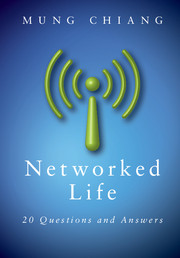Book contents
- Frontmatter
- Contents
- Preface
- Acknowledgements
- Roadmap
- 1 What makes CDMA work for my smartphone?
- 2 How does Google sell ad spaces?
- 3 How does Google rank webpages?
- 4 How does Netflix recommend movies?
- 5 When can I trust an average rating on Amazon?
- 6 Why does Wikipedia even work?
- 7 How do I viralize a YouTube video and tip a Groupon deal?
- 8 How do I influence people on Facebook and Twitter?
- 9 Can I really reach anyone in six steps?
- 10 Does the Internet have an Achilles' heel?
- 11 Why do AT&T and Verizon Wireless charge me $10 a GB?
- 12 How can I pay less for each GB?
- 13 How does traffic get through the Internet?
- 14 Why doesn't the Internet collapse under congestion?
- 15 How can Skype and Bit Torrent be free?
- 16 What's inside the cloud of iCloud?
- 17 IPTV and Netflix: How can the Internet support video?
- 18 Why is WiFi faster at home than at a hotspot?
- 19 Why am I getting only a few % of the advertised 4G speed?
- 20 Is it fair that my neighbor's iPad downloads faster?
- Index
- Notes
5 - When can I trust an average rating on Amazon?
Published online by Cambridge University Press: 05 November 2012
- Frontmatter
- Contents
- Preface
- Acknowledgements
- Roadmap
- 1 What makes CDMA work for my smartphone?
- 2 How does Google sell ad spaces?
- 3 How does Google rank webpages?
- 4 How does Netflix recommend movies?
- 5 When can I trust an average rating on Amazon?
- 6 Why does Wikipedia even work?
- 7 How do I viralize a YouTube video and tip a Groupon deal?
- 8 How do I influence people on Facebook and Twitter?
- 9 Can I really reach anyone in six steps?
- 10 Does the Internet have an Achilles' heel?
- 11 Why do AT&T and Verizon Wireless charge me $10 a GB?
- 12 How can I pay less for each GB?
- 13 How does traffic get through the Internet?
- 14 Why doesn't the Internet collapse under congestion?
- 15 How can Skype and Bit Torrent be free?
- 16 What's inside the cloud of iCloud?
- 17 IPTV and Netflix: How can the Internet support video?
- 18 Why is WiFi faster at home than at a hotspot?
- 19 Why am I getting only a few % of the advertised 4G speed?
- 20 Is it fair that my neighbor's iPad downloads faster?
- Index
- Notes
Summary
In this and the next three chapters, we will walk through a remarkable landscape of intellectual foundations. But sometimes we will also see significant gaps between theory and practice.
A Short Answer
We continue with the theme of recommendation. Webpage ranking in Chapter 3 turns a graph into a rank-ordered list of nodes. Movie ranking in Chapter 4 turns a weighted bipartite user–movie graph into a set of rank-ordered lists of movies, with one list per user. We now examine the aggregation of a vector of rating scores by reviewers of a product or service, and turn that vector into a scalar for each product. These scalars may in turn be used to rank order a set of similar products. In Chapter 6, we will further study aggregation of many vectors into a single vector.
When you shop on Amazon, likely you will pay attention to the number of stars shown below each product. But you should also care about the number of reviews behind that averaged number of stars. Intuitively, you know that a product with two reviews, both 5 stars, might not be better than a competing product with one hundred reviews and an average of 4.5 stars, especially if these one hundred reviews are all 4 and 5 stars and the reviewers are somewhat trustworthy. We will see how such intuition can be sharpened.
In most online review systems, each review consists of three fields:
rating, a numerical score often on the scale of 1–5 stars (this is the focus of our study),
review, in the form of text, and
review of review, often a binary up or down vote.
Information
- Type
- Chapter
- Information
- Networked Life20 Questions and Answers, pp. 89 - 109Publisher: Cambridge University PressPrint publication year: 2012
